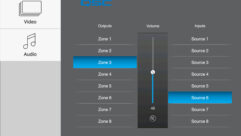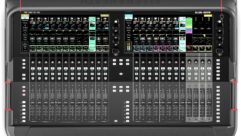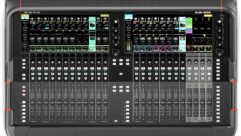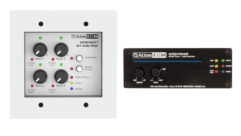Paging Mixers
Jun 1, 2003 12:00 PM,
Randy Alberts
Not every contracting job is an interactive, high-tech museum or a state-of-the-art house-of-worship or music-performance venue. Most people have done more than their share of jobs serving far simpler market needs such as paging lost children at a store or proclaiming, “Your table is ready,” over the blare of background music and a jukebox. Easy, right? Maybe, but if you’ve ever struggled to even recognize your own name over a muddy restaurant announce system or have been paged loud enough to drive away with the early stages of tinnitus in one of those tiny linoleum-floored car repair waiting rooms, you know that “easy” is not often the case.
Paging mixers can be used for a variety of sound installations and applications and are typically one of several elements found in a public announcement sound system that includes amplifiers, routers, and paging stations, including just about any possible combination of low-impedance and 70V loudspeakers in foreground, background, wall, ceiling, indoor, or outdoor installations. Working like most mixers do, these devices accept a range of XLR microphone, RCA, and ¼-inch phono line level, CD, DVD, telephone/TV, and fire alarm inputs and mixes and distributes typically mono signals to various destination zones.
Some form of channel priority mixing/muting and background music ducking when cutting in for pages and announcements is part of every paging mixer, as well: how else will the kids firing away on the video games in the back room hear over the overhead, piped-in local alt-rock station to know when the family’s calzone order is ready?
The focus of the following product descriptions (listed alphabetically by manufacturer) is on rackmountable mixers with at least two inputs and one or more zone assignment options, though a handful of combination tabletop paging mixer/amplifiers are included, as well. What isn’t described are automatic mixers, which can be repurposed for paging but typically are used for multimic boardrooms and courtrooms, microphone preamp mixers without ducking and priority features, and the large networked mainframe digital signal-processing, computer-controlled paging systems that most people hear every day in corporate offices, public transit stations, sports stadiums, shopping malls, and even pizza places.
Platforms like the Klotz Digital Varizone, the Telex/Dynacord ProMatrix, the E-V/Dynacord ProAnnounce, the Symetrix SymNet audio matrix, the Biamp VRAM and AudioFlex, and offerings from companies such as TOA, Bogen, Peavey/Architectural Acoustics, and PagePac by Valcom could well fill another buyers’ guide’s worth of useful information on that subject alone.
Satisfying the needs of your entertainment, corporate, and service industry clients to clearly and seamlessly page, address, serve, and communicate with their customers and staff can be a challenge. However, as with every other sector of systems contracting, from intercoms to video displays, paging mixers have made major strides in convenience, versatility, and audio quality during the past few years. I researched what’s available in the market for basic paging mixers priced under $1,300 and found plenty to report on.
The GR1 and GR05 from Allen and Heath are two single-rackspace, multiple-output zone mixers intended for small- to medium-size installation applications in need of music and paging/zoning capabilities. The GR1, which provides built-in compression/limiting and a priority ducking system for input channels 1 through 3, accepts as many as three mono microphone and three stereo line inputs, each routable to any output or combination of outputs. Front-panel features include channel pan, mute, peak, and mic/aux/line controls per channel, as well as a scribble strip for channel naming. Under-the-lid jumpers and trim pots allow for installation-specific user adjustments, and the GR1 is fully expandable using the SysLink bus interconnect system. Used in smaller installations where nontechnical staff access a sound system, the GR05 can easily route two mic and three stereo inputs to any of four outputs and includes priority channel ducking.
Bogen Communications‘ ProMatrix Model PM3000 is a digitally matrixed preamp/mixer targeted for restaurant, lounge/bar, hotel, factory, and other facilities requiring multiple audio sources and voice paging inputs. Four unbalanced aux and two balanced microphone inputs can be individually assigned to each of three output channels/zones, and one of the mic inputs can be programmed for telephone paging applications. Each input on the PM3000 may also be assigned a variety of priority levels per output channel and automatically switched, based on input signal input activity. Also included on the PM3000 is automatic fade-in of audio source following voice pages, user- and password-protected programming modes, and a frontmounted, removable control panel.
The Cloud Z8II eight-zone venue mixer (distributed by Biamp) is a feature-packed, easy-to-use mixer for leisure venues, hotels, retail complexes, and large licensed premises. Accepting microphone, paging microphone, and as many as six CD, video, satellite, and other music line input sources, the Z8II also features balanced zone outputs and operates in mono mode while handling all music inputs through stereo RCA connectors. The unit’s dedicated paging microphone input channel features preselectable signal level controls per zone. Separate equalization is provided for music inputs on each output zone, and customized optional plug-in filter cards are available for installations using Bose speaker systems, as well. Rear-panel preset treble and bass controls (factory optimized for music signals) are accessible through the unit’s back panel.
If you need to combine and distribute four stereo music sources and two paging microphones over four zones, the DN-A850 zone mixing amplifier from Denon can handle the job. This 4-channel mono mixer and 4-channel 50W power amp tandem has independent bass/treble and zone paging controls and a preoutput jack per zone for daisy-chaining to other amps and as many as eight zones. Page all and page zone function with -30 dB music mute is included as is line 1/mic 1 priority settings and local or remote volume control capability for each of the DN-A850’s four zones.
The 2100 Programmable Priority Mixer from Edcor Electronics is a cost-effective tabletop mixer with two programmable priority inputs and one auxiliary line input. Designed to accept balanced or unbalanced signals ranging from -65 dB (microphone level) to +15 dB (high auxiliary level), the 2100 also provides selectable +15 VDC phantom power for use with electret microphones, as well. The 2100, suited for any facility needing a simple voice/music priority solution, weighs in at just two pounds, comes with a 12 VAC adapter, and carries a two-year warranty.
Part of a new line introduced at least year’s InfoComm, the Electro-Voice MA-1212 is a 120W, 12-input rackmount paging mixer/amp designed for larger BGM/paging and public address system installations where expandability is required. Twelve separate input controls on the MA-1212 handle each of 12 XLR mic and RCA line input sources. Any signal appearing at input 1 automatically mutes other channels unless the mute function is defeated per channel through a back-panel switch. All Electro-Voice MA Series mixer amplifiers feature ten balanced mic or line inputs available with 24V phantom power, two auxiliary stereo-summing inputs with four-level sensitivity adjustment, and balanced line-level output for adding additional power amplifiers. Twenty-four-volt powered operation is available for emergency power requirements, and all models feature adjustable-level telephone paging input and independently adjustable low-power monitor output.
Formula Sound‘s ZM243 digital control mixer-zoner is a digitally controlled, single-rackspace-mounted unit with music, mic, and fire alarm override inputs. The front panel provides controls over one of two balanced mic inputs and four stereo line inputs for each of the unit’s three input zones/channels, as well as LEDs indicating music source input, active mic, priority signal presence, and remote panel control. All outputs can be VCA remote controlled by any remote potentiometer, and treble and bass controls through presets are accessible through holes in the back panel. The two mic channels on the ZM243 are fitted with low-frequency cutoff EQ presets, as well.
From Inter-M is the PA-1000BR commercial paging mixer/receiver with adjustable telephone paging input, priority voice-activated muting, and digital AM/FM tuner with 12-station presets on board for background music (BGM) and music-on-hold (MOH). This 30W paging mixer/amplifier sports two balanced low- or unbalanced high-impedance mic inputs and a third input for connection of a line level source. The unit also supports input from a 600ž (0.775V) telephone page port. The PA-1000BR has overall bass and treble controls and a useful built-in four-tone chime for page preannounces. Nice touch!
ProTech Audio‘s Model 65306 is an automatic ambient-noise-sensing level control system with built-in prioritizing mixer for public address and background music systems applications. The 65306, which features a compressor/limiter on each of four mic inputs, can work with special sensing microphones and paging speakers to automatically adjust sound system levels and compensate for fluctuating ambient background noise factors. Each input’s priority setting is user-adjustable for overriding lower level inputs. The 65306’s built-in compressor and output peak limiter circuits optimize a wide range of input signal levels, and the unit features selectable metering of output gain levels.
Two paging and music-mixing solutions from Radio Design Labs (RDL) include the ST-VP1 voice-over/paging module and ST-VP2 automatic ducking module. These highly compact RDL “Stick-On” mixing solutions for voice-over and paging applications, which can be wired to constantly feed a paging amplifier’s line level input, are each about the size of a harmonica case and can be rackmounted or easily adhered to any surface in a workspace within a finger’s reach. The ST-VP1 accepts one line level music source and one line level voice source — such as a line level telephone paging signal or a microphone that’s been preamped to line level. Like the ST-VP1, the ST-VP2 features adjustable fade depth but adds adjustable music fade depth and a built-in AGC compressor on the unit’s music inputs. When a page is initiated, the ST-VP2 then automatically senses audio level at its input, lowers music to a set level, and then automatically fades up the music after a page is completed.
Rane‘s CP 64 commercial preamplifier is designed to serve two independent zones in restaurants, bars, health clubs, and corporate offices. Two gated microphone/line paging inputs and four line level program inputs are provided on the unit’s back panel, as are page, program, and zone signal expansion ports. The CP 64 supports priority page, nonpriority page, priority program, and nonpriority program levels. Any of four program inputs may be independently assigned to each zone, one of those being a gated priority program input that overrides any non-priority program selection in an assigned zone when signal is detected at its input. The ducker depth control on the CP 64 is screwdriver adjustable from the front panel, and an optional security cover is available for the CP 64.
The 450 dual zone priority mixer from Symetrix is a one-rackspace unit that combines two mono mic/line inputs and four stereo line inputs for a number of club, restaurant, hotel, and house of worship public address and paging applications. Each mic/line input may be assigned to a stereo output zone, a mono output zone, or both and features +48V phantom power and low-frequency filter. The 450’s hierarchical priority structure permits both mic/line inputs and the first stereo line input to have priority over other inputs assigned to the same zone. The 450 can also be remotely controlled by any standard 50k linear potentiometer.
Recently shipping from TOA Electronics is the company’s new BG-M Series mixer/amplifiers line, ideal for paging, music distribution, and messaging-on-hold applications. Sharing a piece of TOA’s M900 MkII modular chassis design approach, the 120W BG-1120 (the 15W BG-1015 is also available) has a single TOA plug-in expansion port supporting a wide range of microphone, line, and other I/O modules for custom configurations. This compact 5-channel mixer/amp features 25V, 70V, and 4ž speaker outputs, balanced mic page and telephone page inputs, and MOH output. Automute sense control on the BG-M series is provided for adjusting mute activation threshold, and an automute function allows voice-activated paging override of aux/program or module without interrupting MOH output. Other features include bass/treble controls, insert jacks and signal, clip, and power indicators.
Whirlwind/US Audio offers its MPM-1 priority paging mixer (MPM-1V available with video support) for easily managing audio and paging functions in single-zone applications. The front panel of this single-rackspace unit includes two priority mic/line level controls, three input level controls, three program-select buttons, master volume, and system control over low, low-mid, high-mid, and high-EQ bands. A newly added feature to the MPM-1 and MPM-1V allows the units’ ducking feature to be active on only one side of the output section. Stereo RCA phono and balanced XLR outputs are stereo/mono switchable from the rear panel, and the latter can be used in mono to drive 70V line amps for ceiling speakers while keeping the RCA source inputs in stereo. The included MPM-1RV remote control adjusts the main volume of all outputs from a remote location, ideal for mounting behind a bar, at a concierge station, or below a security desk or other convenient location where access is easy. The control is mounted on a single-gang stainless-steel wall plate and connects with ordinary 3-conductor hookup wire through solderless screw terminals.
The Yamaha MV8000 is a professional two-rackspace analog mixer with eight mic/line mono inputs, one stereo channel with A/B inputs, zone assign switching, and a paging function with stereo channel ducking control. Useful in a number of applications, including contract sound and paging, the MV8000 sports balanced XLR-type connectors, balanced insert I/Os with TRS ¼-inch jacks, individual channel noise gates, a global compressor on all mono channels, 2-band EQ, and selectable 48V phantom power on the balanced microphone inputs. The output section features dual stereo outputs, each switchable to mono, and the mixer’s high-quality microphone preamps record-out jacks make the MV8000 a useful paging mixer solution that is also handy for live, installed, and broadcast sound applications alike.
Randy Alberts (www.opendooredit.com) is a journalist, an author, and a Mix magazine contributing editor. His book Tascam: 30 Years of Recording Evolution for Hal Leonard Publishing is available direct from the author or online at Amazon.com and Barnes and Noble.
For More Information
Allen and Heath
www.allen-heath.co.uk
Ž 201
Bogen Communications
www.bogen.com
Ž 202
Cloud
www.cloud.co.uk
Ž 203
Denon
www.denon.com
Ž 204
Edcor Electronics
www.edcorusa.com
Ž 205
Electro-Voice
www.electrovoice.com
Ž 206
Formula Sound
www.formula-sound.com
Ž 207
Inter-M
www.inter-m.com
Ž 208
ProTech Audio
www.protechaudio.com
Ž 209
Radio Design Labs
www.rdlnet.com
Ž 210
Rane
www.rane.com
Ž 211
Symetrix
www.symetrixaudio.com
Ž 212
TOA Electronics
www.toaelectronics.com
Ž 213
Whirlwind/US Audio
www.whirlwindusa.com
Ž 214
Yamaha
www.yamaha.com
Ž 215
Ž Circle this number on Reader Service Card or visit freeproductinfo.net/svc










